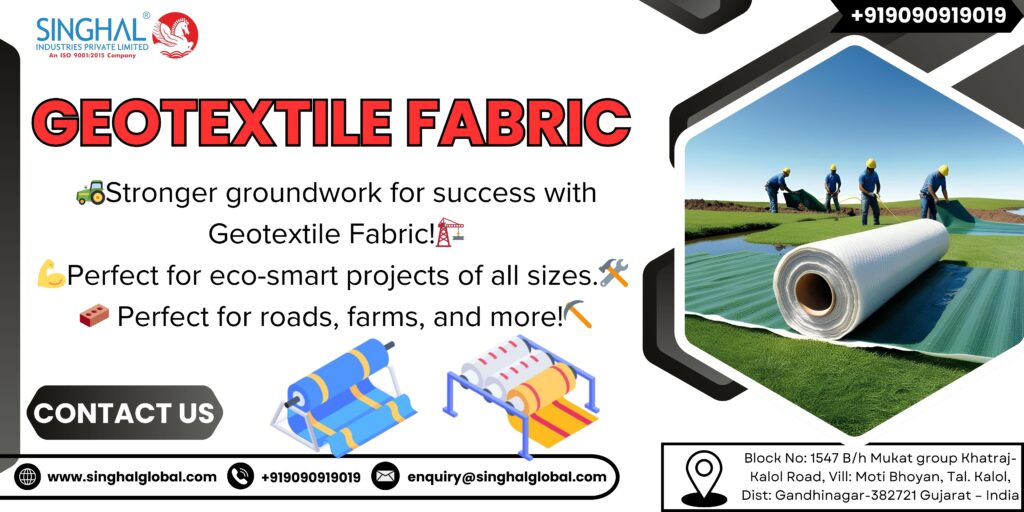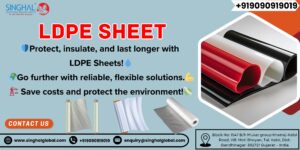Erosion is one of the severe problems encountered in civil engineering, particularly for areas characterized with rain, water flow, or heavy traffic. Generally on construction sites, roadside slopes, riverbanks or even agricultural fields in towns, this type of soil erosion can lead to land degradation, property destruction and increased costs of maintaining that land. And there comes in its place Geotextile manufacturers in India as a significant solution. Playing the role of separation, filtration, reinforcement, and protection layer, this fabric has become an indispensable instrument for modern construction and environmental protection.
In the last decade or so, Geotextile in road construction has become so popular not just in India but also outside. With more infrastructure projects and need for sustainable practices, geotextile manufacturers in India are making high performance products suitable for erosion control, road stability, drainage system work and so on.
What is Geotextile Fabric?
Geotextile fabric is a porous textile material that was produced from the polypropylene/polyester, and was created for civil and environmental engineering. It can be either woven or non-woven, according to use. Woven geo textiles are commonly used for reinforcement and separation, whereas non – weaved geo textiles are used for filtration and drainage.
This material serves as a screen among soil levels allowing for water permeability, preventing soil particles movement, decrease in surface abrasion, and increased service life of infrastructure.
The Role of Geotextile in Road Construction
The construction of roads is one the major uses of geotextiles especially in places of unstable soils. It serves as a separator which prevents the blending of various soil types and keeps the strength of each layer.
Geotextiles in retarding the rutting, cracking and sinking of the road surface by supporting the base. They also lengthen the life of the pavement and reduce the number of maintenance. Roads built using geotextiles suffer fewer failures and have a better load distribution.
Due to the varied terrain and climate of India, geotextile application in roadwork has since become very important. Many Geotextile manufacturers in India manufacture products that are specifically meant for National Highway projects, even those in rural areas, under PMGSY and even private industrial pathways.
How Geotextile Fabric Helps in Erosion Control
In most situations soil erosion is caused by either wind or water removing the topsoil from a particular location. This turns out to be a real problem in slopes, hills, riverbanks and construction sites. The problem is combated by the geotextile fabric in different ways:
- Keeps soil in a place.
- It will let water to pass without disturbing the soil.
- By covering the top soil, it encourages vegetation growth.
- It strengthens weak or loose ground in sensitive zones.
Whether beneath riprap, along steep slopes, or around drainage structures, geotextile gives permanent erosion protection at no cost to the landscape.
In agricultural zones, as well as in urban development sites, geotextiles serve as a preventive measure for soil loss and sediment runoff. They can be easily installed and low maintenance is required once they have been set.
Applications of Geotextile Fabric Beyond Roads
Though Geotextile road construction is a major use case, its versatility extends far beyond highways and streets. Here are some other common applications:
- Drainage systems: In retaining wall, sports field and garden for proper water flow.
- Coastal protection: Along the shorelines to minimise the effects of the wave and also prevent erosion of the sand.
- Railways: For bettering track stability and soil movement prevention.
- Retaining walls: Behind walls to allow drainage while preventing soil erosion.
- Agriculture: In terrace farming and plantation zones to retain topsoil.
Due to infrastructure expansion in size and intricacy, it is no longer surprising for many government and private projects to include geotextile fabric as a mandatory element.
What Makes Geotextile Fabric Effective?
It is through the combination of strength and permeability that geotextile fabric performs successfully in the control of erosion. It produces in a variety of weights, thicknesses and roll sizes to suit specific requirements. The material is UV ray resistant, it resists biological degradation and chemicals, and is therefore ideal for long term use in high strain environments.
Whether or not the geotextile is woven or non-woven depends upon the application. Woven types are usually stronger and applied to reinforcement and separation. Non wovens are the best types for drainage and filtration. In most cases, reliable Indian geotextile manufacturers offer suggestions depending on soil testing and requirements of the project.
Conclusion
Geotextile fabric has changed our attitude towards erosion control and infrastructure development. It is no longer a luxury, but a necessity in contemporary building and environmental management. Whether on stabilizing slopes or riverbanks or for roadbuilding, geotextile provides a natural, economical and dependable solution.
As there are many geotextile manufacturers in India making high grade materials appropriate for different terrains and needs, now the developer of projects can boldly include this intelligent material into his plans. With the increased urgency in need for resilient infrastructure, geotextiles will continue with ensuring that the construction is sustainable and safer.
Frequently Asked Questions (FAQs)
Q.1 Can geotextile fabric be used to control erosion?
Indeed, geotextile fabric is designed for the prevention of erosion. It anchors soil, enables water to disperse, and sustains vegetation, the ideal thing to use for slope and riverbank as well as construction site protection.
Q.2 Can geotextile fabric be used in road construction?
Absolutely. Geotextile is extensively used in the subgrade stabilization in the road construction projects, layer separation and reinforcement projects.
Q.3 What sizes and weights are available for geotextile fabric?
Geotextile fabric is available in widths (1-6 meters) and lengths (100 m per roll) and weight (100 GSM – 1000 GSM; depending on the place of use). Your supplier may recommend the best one for your particular usage.
Q.4 How does geotextile fabric prevent soil contamination?
Geotextile is a barrier between the contaminated and non contaminated soils thus preventing blending of different layers. It also purifies water blocking the bad particles and keeping the soil quality intact on the either side of it.









